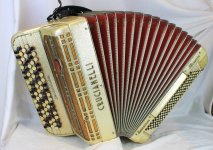KiwiSqueezer
Active member
I am puzzled by a B-system CBA I have seen recently. Its 120 bass buttons are arranged with 3 rows of fundamental notes, and 3 rows of chords (no dim 7ths). I've discovered a little about the 'French 3 3' layout, where, for example, the 'C' column goes Ab, E, C, CM, Cm, C7, but this one goes Eb, E, C, CM, Cm, C7. In the apparently 'conventional' French layout, the first row's Eb would be on the adjacent 'G' column, whereas this box has Bb. Thus, comparing the two layouts, the row nearest the bellows is effectively shifted by one button. This accordion's layout is otherwise conventional Stradella.
Searching old posts shows that Paul De Bra considers that this accordion's 'shifted French' layout is familiar to him, whereas what I have called the 'conventional' '3 3' layout isn't.
I'm no music theorist, and fairly new to accordions - there's so much to learn! Please can anyone explain why there may be (at least?) two variants of the 'French 3 3' bass layout? Is it a regional preference? This box was probably bought new in Gelderland, Holland. Are there good musical or ergonomic reasons for the 'shifted' variant? Any thoughts welcome!
Searching old posts shows that Paul De Bra considers that this accordion's 'shifted French' layout is familiar to him, whereas what I have called the 'conventional' '3 3' layout isn't.
I'm no music theorist, and fairly new to accordions - there's so much to learn! Please can anyone explain why there may be (at least?) two variants of the 'French 3 3' bass layout? Is it a regional preference? This box was probably bought new in Gelderland, Holland. Are there good musical or ergonomic reasons for the 'shifted' variant? Any thoughts welcome!
Last edited:

